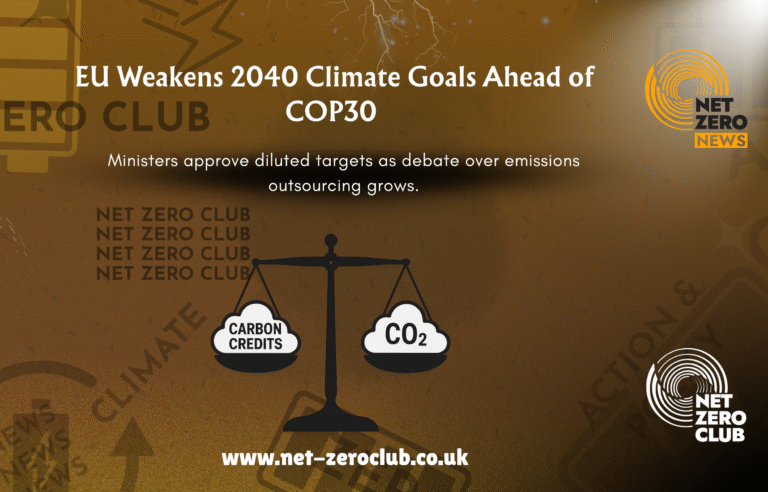UK Government’s 2035 Carbon Budget Delivery Plan Explained

Greetings, Net Zero News Community,
The UK government has recently unveiled a comprehensive plan detailing its approach to reducing greenhouse gas emissions throughout the 2030s, a critical juncture on the path to achieving net-zero emissions by 2050. This plan, which has been highly anticipated, outlines the strategies the government intends to adopt in order to meet its legally mandated carbon budgets as established under the Climate Change Act.
As part of the ongoing commitment to combat climate change, the government is required to set carbon budgets that delineate strict limits on emissions over five-year periods. Following the announcement in 2021 of a target to reduce emissions by 78% by 2035 under the sixth carbon budget, the delivery plan outlining how these targets would be met faced significant scrutiny and legal challenges. The newly released Carbon Budget and Growth Delivery Plan (CBGD) represents the third draft of this delivery plan, following two previous iterations that were deemed unlawful by the High Court.
In contrast to its predecessors, this latest plan asserts that the government possesses adequate climate policies to fulfil its sixth carbon budget and has the potential to meet “96-99%” of its international commitments under the Paris Agreement. This comes despite a noticeable reduction in expectations surrounding various climate initiatives, including clean hydrogen production, tree planting, and carbon capture and storage (CCS).
The introduction of the CBGD plan occurs against a backdrop of a fragmented political consensus on climate action in the UK, with the Conservative party expressing intentions to repeal the Climate Change Act and the hard-right Reform UK party consistently criticising net-zero policies. In this context, the CBGD plan serves as a crucial blueprint for the government’s climate agenda moving forward.
Understanding the New Carbon Budget Delivery Plan
The new delivery plan is pivotal as it outlines the government’s strategy to meet both domestic and international emissions targets. It includes a comprehensive overview document alongside a detailed 238-page report that specifies the expected emissions reductions across various sectors of the economy.
The government has framed its climate policies as a means to regain control over the UK’s energy landscape, aiming to boost domestic renewable energy production, reduce energy bills, and create jobs in the process. The plan also highlights how Labour’s climate initiatives are designed to enhance the quality of life and safeguard the natural environment.
Among the components of the delivery plan are a technical annex detailing modelling and accounting methodologies, an investor prospectus outlining net-zero investment opportunities within the UK, and a methane action plan that aims to reduce greenhouse gas emissions across different sectors.
The Legal Background of the Delivery Plan
This iteration of the carbon budget delivery plan is particularly significant as it emerges from the legal challenges faced by previous drafts. The sixth carbon budget, which was legislated in 2021 and mandates a 78% emissions cut below 1990 levels by 2035, has been scrutinised for not adequately detailing how the government would achieve these ambitious targets.
In July 2022, the High Court ruled that the government had violated sections 13 and 14 of the Climate Change Act by failing to provide sufficient information on emissions savings from individual policies. The court found that the then-Secretary of State, Kwasi Kwarteng, lacked adequate knowledge regarding the expected emissions reductions from the proposed policies. As a result, the government was mandated to revise its strategy, culminating in the March 2023 delivery plan, which was subsequently challenged again in court.
Following further legal scrutiny, the court ruled in May 2024 that the Secretary of State, Claire Coutinho, had not been sufficiently informed about the risks associated with the proposed policies. This led to a new deadline for the government to publish a revised plan, which has now been extended due to the complexities of the political landscape.
Key Highlights of the Carbon Budget Delivery Plan
The new delivery plan articulates a series of measures aimed at reducing emissions across multiple sectors. It confirms that the government has robust policies in place to meet the UK’s fourth and fifth carbon budgets for the period 2023-2032. Notably, it establishes that additional policies are in the pipeline to ensure that the emissions cuts required for the sixth carbon budget are also achieved.
Specifically, the plan states that 76% of the emissions reductions required for the sixth carbon budget are already accounted for through policies that have been implemented, adopted, or are planned. The remaining reductions will be met through a set of 169 additional proposals, which range from the promotion of electrified steel plants to enhanced tree-planting initiatives. The report also takes into consideration another 12 early-stage proposals.
Moreover, the government acknowledges its international climate targets under the Paris Agreement, known as nationally determined contributions (NDCs). The latest calculations indicate that UK emissions will be reduced by 66% from 1990 levels by 2030 and by 81% by 2035, which exceeds the UK’s NDC targets for these years by 96% and 99%, respectively. The government plans to explore further measures to enhance delivery and ensure compliance with its international commitments.
Assessing the Implications for Various Sectors
The CBGD plan lays out an extensive framework for how different sectors will contribute to achieving the UK’s emissions targets. Below, we will delve into the implications for key sectors including transport, heating and buildings, industry, electricity, and agriculture.
Transport
As the largest source of emissions in the UK, the transport sector accounted for 26% of total emissions in 2023. When factoring in international aviation and shipping, this figure rises to 35%. Road travel remains the predominant contributor, responsible for around 90% of domestic transport emissions, largely due to petrol and diesel vehicles.
In 2024, the newly elected Labour government reinstated a 2030 ban on the sale of new petrol and diesel vehicles, a target originally set by the previous Conservative administration. However, despite the growing uptake of electric vehicles (EVs), the market is currently projected to miss the zero-emissions vehicle (ZEV) mandate for 2025.
The CBGD plan establishes targets for the proportion of ZEV cars on UK roads, aiming for 21% by 2030 and 48% by 2035, which are less ambitious than previous targets. Additionally, the plan acknowledges key risks, such as the potential failure of zero-emission vehicles to displace petrol and diesel vehicles at the anticipated rate, as well as unanticipated growth in travel demand.
Heat and Buildings
Buildings contribute significantly to the UK’s emissions, with heating systems primarily powered by gas. In 2023, the sector accounted for 17% of total emissions. The government’s “warm homes plan,” set to be introduced soon, aims to lift over a million households out of fuel poverty by 2030 through the rollout of heat pumps and energy efficiency measures.
While the government has committed to expanding low-carbon heating solutions, it has removed the previous target to ban the sale of gas boilers by 2035. This has elicited mixed reactions, as public sentiment towards policies perceived as “boiler bans” remains contentious. Overall, the plan seeks to normalise low-carbon heating solutions over the coming decade.
Industry, Carbon Capture and Storage, and Hydrogen
The industrial sector represented 15% of total emissions in 2023, with significant potential to contribute to emissions reductions. The government’s strategy includes a refreshed industrial decarbonisation plan aimed at fostering a competitive low-carbon industrial base. However, the expectations for resource efficiency and carbon capture and storage have been scaled back in this latest iteration, raising concerns among experts.
On hydrogen, the plan indicates continued support for clean hydrogen production, with specific targets set for 2030 and 2035 that are notably less ambitious than previous strategies. The government is expected to publish a new hydrogen strategy in the near future, which will clarify its approach to developing this critical technology.
Electricity
The power sector has seen significant decarbonisation over the past decade, yet it still accounted for 10% of the UK’s emissions in 2023. The CBGD plan acknowledges the need to address the disparity in electricity pricing, which has hindered the adoption of clean technologies.
The government’s focus will be on expanding clean power technologies and investing in infrastructure to support this growth. Significant investments are planned for the electricity network, with a commitment to ensuring that the necessary planning arrangements and supply chains are in place to facilitate rapid expansion in this sector.
Agriculture and Land Use
Agriculture and land use contribute 11% of the UK’s emissions, primarily due to livestock farming. The CBGD plan outlines several initiatives aimed at reducing emissions in this sector, including the Environmental Land Management Schemes (ELMs), which are designed to incentivise sustainable farming practices.
However, the new plan has revised down expectations for the adoption of low-carbon practices among farmers, alongside targets for peatland restoration and tree planting. This has raised concerns about the adequacy of the government’s strategy to address emissions from agriculture, especially in light of the pressing need to restore natural habitats and enhance carbon sinks.
Conclusion
The newly released Carbon Budget and Growth Delivery Plan marks a pivotal moment for the UK’s climate strategy as it navigates the complexities of achieving net-zero emissions by 2050. While the plan highlights several positive steps forward, including the reinstatement of important targets and an emphasis on domestic renewable energy, it also raises critical questions about the scaling back of ambitions in key areas.
As we look ahead, it is essential for the UK government to maintain a clear and ambitious vision for its climate policies, ensuring that all sectors contribute effectively to meeting emissions targets while also addressing public concerns. The path to net-zero is fraught with challenges, but with continued commitment and collaboration, it remains an achievable goal.
Thank you for joining us in this exploration of the UK’s latest climate plan. Together, we must advocate for robust action on climate change and support initiatives that will lead us towards a sustainable future.

 Got net-zero news, project updates, or product launches to share?
Got net-zero news, project updates, or product launches to share? 


